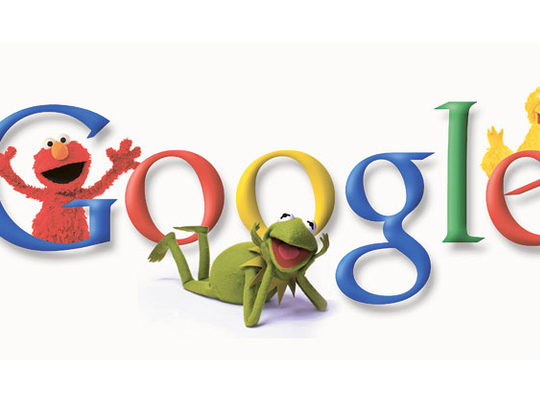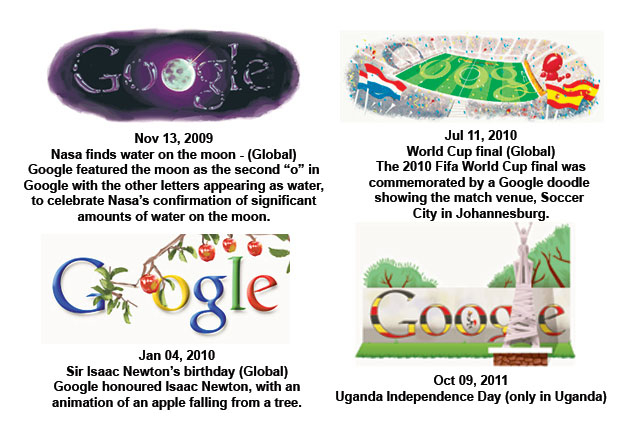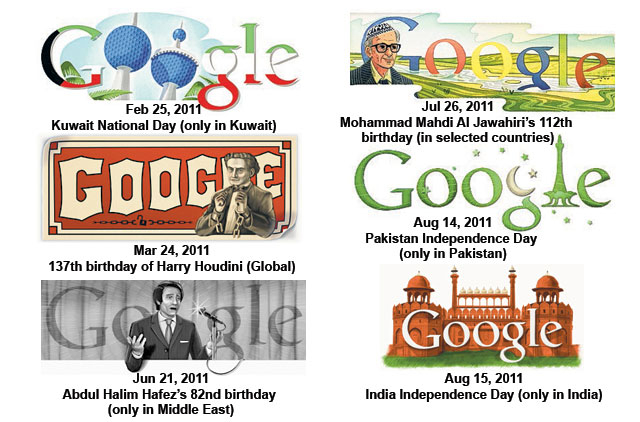
They are artistic and informative. Google's doodles are an expression of what one can call creative "online drawings" in the cyber age.
It is one way to draw people in and make them enjoy and learn about the topic depicted, say experts. From a business perspective, they bring in viewers. And more viewers means more searches using Google. In some ways, it helps consolidate the giant, corporate brand, giving it an edge over its competitors.
"There are not many brands that have the audacity to decorate their brand's logo to make it a more pleasurable, fun and informative experience for their consumers," said M. Shaharyar Omar, marketing director of Dubai-based Pan Arab Research Centre. "It is a kind of fun, basically, providing information to consumers and raising cultural awareness."
However, Najeeb Jarar, Google's product marketing manger for the Middle East and North Africa (Mena) region, expressed a different view.
He said that it is not an issue of a brand or a competitor's edge. It is, rather, "a way to bring the viewer's attention to certain events or to particular figures, whose way of thinking had helped the advancement of humanity, or to tell our viewers about specific events that are taking place on a certain day."
However, he acknowledged that when Google posts a doodle based on a figure from Arabic culture, the number of viewers who click on the name of that personality or to other links to learn more about their background increases noticeably.
"On a normal day, a limited number of people would be interested in learning more about some celebrities. But when we put a doodle celebrating their birthday or commemorating a certain occasion, many people show curiosity to read more about them. In the following couple of days, [we have noticed] there is an increase in searches on these people [or occasions]," Jarar said, without giving any figures on the number of viewers or users or the percentage of increase.
In fact, Steve Rubel, executive vice-president of Edelman, one of the world's largest indpendent communications firms, said in one of his blogs that "the Google Doodle is — arguably — one of the biggest PR coups in the world," and can drive a "tonne of traffic to sites that rank highly on the search term Google ties to it. Just how much traffic? How about two million page views or more if your web page is the top result.
"Given their broad nature, most of the searches that the doodles link to tend to rank Wikipedia articles very highly. Therefore, if we look at the amount of traffic these Wikipedia pages get on Doodle Day, we can get a sense of just how powerful they are as a traffic driver," Rubel said.
On many days and occasions, the logo of the global internet provider of Google changes to celebrate holidays, anniversaries and the lives of celebrities all over the world.
They range from Halloween celebrations in the US, birthday of Mahatma Gandhi or physicist Albert Einstein, celebrating the late Iraqi poet Nazik Al Malaika or the late Egyptian singer Abdul Halim Hafez.
Also, Google shows a special colourless logo on some local home pages to mark a major tragedy. The design first appeared on the Google Poland home page following the death of President Kech Kaczynkki in April 2010. Shortly afterwards, the logo was used in China and Hong Kong to pay respects to the victims of the Qinghai earthquake.
According to Omar, figures point to a "significant increase" in both internet penetration and Google users. The increase is recorded mainly among middle class users.
"It is basically because the middle class has access to PCs and mobile phones. They have access to the internet quite easily," Omar told Gulf News. "Google is the top site visited in the UAE and is being used by 62 per cent of UAE net users" besides many other Arab countries.
With nearly 74 per cent, the UAE has the highest internet penetration among several Arab countries. This is followed by Qatar with 73 per cent and Kuwait with 66 per cent, according to Omar.
Statistics have also shown a noticeable increase in the percentage of Google users in Egypt, one of the fastest growing markets in the region. From 57 per cent in 2010, the percentage reached 64 in 2011.
According to statistics provided by a Target Group Index (TGI) survey, nearly 44 per cent of internet users use Google — 65 per cent in Kuwait, 57 per cent in Bahrain, 61 per cent in Qatar, 44 per cent in Lebanon, 50 per cent in Syria and 57 per cent in Algeria. A higher percentage has been recorded in Jordan, where 72 per cent of internet users use Google.
Jarar noted that Google has, on average, 100 million viewers in the Arab region.
Global differences
Doodles have been regional and global. What might appear in Germany does not appear in the US, and what might appear on the local page in the US doesn't appear in the Arab region, with the exception of global characters or events, such as the birthday of Einstein or the start of the Olympic Games. These internationally-recognised figures are the most popular doodles, said Jarar.
"There are characters, like Batman for example, that are known worldwide, regardless of the people's language and knowledge. [Also] Einstein as well as characters from Open Sesame are well known everywhere regardless of their names in any language; everybody recognises these characters," he said.
Characters which are recognised globally are the most popular because their audiences are international, he said.
Choosing a topic for the doodle is decided mainly by the availability of the given character's birthday or the exact time of an event. Such a condition makes the modern characters win over historical ones.
"We need to know the exact date and not a date that is questionable… and this becomes more difficult the more we go backwards in time," Jarar said.
"People were not recording time exactly by date. They used to record birthdays by year, and events used to be related to years and not specific days. That is why you see fewer historical figures and many more modern characters, where dates are recorded more accurately," he said.
Selected sketches
Creativtiy in logos: how itall started
Google's doodles folklore is preparing to enter its 14th year worldwide. It dates back to 1998, when it first art appeared in honour of the Burning Man Festival.
The company, at that time, was a small business with nearly 50 employees, who wanted to be outside the office to attend a festival and sought to inform the viewers that they were not available in case of technical problems.
It was then, when the web master at Google thought of adding the brand logo to the company's logo.
"Viewers liked the idea, and thought it is a creative one from Google to refer to events in the area,"" Jarar said.
Officially, the doodles in the form known today started in 2001 and went on to illustrate scores of historical developments and anniversaries, among them Bastille Day in France and the Sydney Olympic summer games, as well as Chinese New Year.
But the illustrations did not end there, with subjects as diverse as Canadian national day, the 50th anniversary of understanding DNA and the invention of the bar code warranting their own pictorial presence. Later came the landing on Mars, Teachers Day, the Cricket World Cup, Mothers Day, Valentine Day, Veteran's Day and the Brazilian Carnival festival. Finally, the doodles illustrated ahigh-profile birthdays including the 75th birthday anniversary of Jim Henson, the American puppeteer who is best known as the creator of puppets, and the 96th birthday of Les Paul, the legendary American jazz guitarist credited with the famous Les Paul electric guitar.
"Surprising and delighting Google users with doodles is an awesome creative opportunity," said Ryan Germick, who leads the Doodle Team Creative within the Product Management department at Google's headquarters in Mountain View in the US.
"Mostly, I feel lucky," he added in a written interview with Gulf News. Because it is a global company, Google seems keen to meet the expectations of different backgrounds and cultures, Germick noted, saying, "Google's an incredibly diverse community and we always work with local counterparts to help us better understand cultures and create the best doodles we can abroad."
"Learning on the job is another perk," he said.
The vast majority of artists contributing to Google's doodles come from within the company and are based in the US. However, Google is open to any idea or suggestion by any of its users and viewers for a doodle, Jarar noted. As a way to encourage young talent to participate in designing Google's homepage logo for "millions to see", Google holds a yearly Doodle for Google competition for school children of different age groups. Each year, there is a theme, including "I love Football" and "What I'd like to do someday".
"It's in Google's DNA to love innovation, creativity, and fun," said Germick. "So I'd say Google shapes doodles more than the other way around."
Buring Man Festival
In 1998, the concept of the doodle was born when Google founders Larry Page and Sergey Brin played with the corporate logo to indicate their attendance at the Burning Man festival in the Nevada desert. A stick figure drawing was placed behind the 2nd "o" in the word, Google and the revised logo was intended as a comical message to Google users that the founders were "out of office."
Google featured the moon as the second "o" in Google with the other letters appearing as water, to celebrate Nasa's confirmation of significant amounts of water on the moon.













